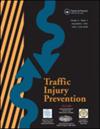Identifying the reciprocal causation between hit-and-run behavior and crash injury severity
IF 1.6
3区 工程技术
Q3 PUBLIC, ENVIRONMENTAL & OCCUPATIONAL HEALTH
引用次数: 0
Abstract
Objective
Hit-and-run behavior is believed to exacerbate the injury severity of traffic crashes due to the delayed emergency response for the victims. However, several previous studies indicated the opposite finding that hit-and-run crashes were associated with less severe injuries. The relevant studies mainly identified the statistical associations between hit-and-run behavior and injury severity without revealing causation between them. To this end, the study aims to explore the reciprocal causation between the two variables.
Method
The two-stage probit model with endogenous regressors is employed to identify the reciprocal causation between hit-and-run behavior and crash injury severity for single- and two-vehicle crashes, respectively, with the use of crash data extracted from the Crash Report Sampling System and Fatality Analysis Reporting System (2016-2019).
Results
The results indicate that 1) for both single- and two-vehicle crashes, the fleeing behavior can significantly increase the injury severity of the victims in the crashes while the severe injury of the victims has a negative impact on the propensity of such behavior, 2) the propensity of hit-and-run behavior is influenced by various instrumental variables such as driver age, gender, alcohol involvement, weekday, area type, and light condition, and 3) crash injury severity is significantly related to the victim age, gender, and vehicle damage.
Conclusions
There is a reciprocal causation between hit-and-run behavior and injury severity in traffic crashes. The analytical results can provide a reasonable explanation for the counterintuitive finding on hit-an-run crashes and help mitigate the injury severity.
确定肇事逃逸行为与车祸伤害严重程度之间的互为因果关系。
目的:肇事逃逸行为被认为会加剧交通事故的伤害严重程度,因为会延误对受害者的紧急救援。然而,之前的一些研究却得出了相反的结论,即肇事逃逸与较轻的受伤程度相关。相关研究主要确定了肇事逃逸行为与受伤严重程度之间的统计关联,但并未揭示两者之间的因果关系。为此,本研究旨在探讨这两个变量之间的相互因果关系:方法:采用内生回归因子的两阶段probit模型,利用碰撞报告抽样系统和死亡事故分析报告系统(2016-2019年)中提取的碰撞数据,分别识别单车碰撞和双车碰撞中肇事逃逸行为与碰撞伤害严重程度之间的互为因果关系:结果表明:1)在单车和双车碰撞事故中,逃逸行为会显著增加碰撞事故中受害者的受伤严重程度,而受害者的严重受伤程度对此类行为的倾向性有负面影响;2)肇事逃逸行为的倾向性受驾驶员年龄、性别、酒精参与程度、工作日、地区类型和光照条件等多种工具变量的影响;3)碰撞事故的受伤严重程度与受害者年龄、性别和车辆损坏程度显著相关:结论:交通事故中的肇事逃逸行为与受伤严重程度之间存在互为因果的关系。结论:交通事故中肇事逃逸行为与受伤严重程度之间存在互为因果的关系,分析结果可以为肇事逃逸事故的反直觉结论提供合理解释,并有助于减轻受伤严重程度。
本文章由计算机程序翻译,如有差异,请以英文原文为准。
求助全文
约1分钟内获得全文
求助全文
来源期刊

Traffic Injury Prevention
PUBLIC, ENVIRONMENTAL & OCCUPATIONAL HEALTH-
CiteScore
3.60
自引率
10.00%
发文量
137
审稿时长
3 months
期刊介绍:
The purpose of Traffic Injury Prevention is to bridge the disciplines of medicine, engineering, public health and traffic safety in order to foster the science of traffic injury prevention. The archival journal focuses on research, interventions and evaluations within the areas of traffic safety, crash causation, injury prevention and treatment.
General topics within the journal''s scope are driver behavior, road infrastructure, emerging crash avoidance technologies, crash and injury epidemiology, alcohol and drugs, impact injury biomechanics, vehicle crashworthiness, occupant restraints, pedestrian safety, evaluation of interventions, economic consequences and emergency and clinical care with specific application to traffic injury prevention. The journal includes full length papers, review articles, case studies, brief technical notes and commentaries.
 求助内容:
求助内容: 应助结果提醒方式:
应助结果提醒方式:


